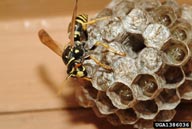April can fool you all month long. Even if your pest-prevention responsibilities lie mostly indoors where frost and rain rarely intrude — a school, an office building, a museum, your home — April has some tricks up her sleeve. Those perimeter pests, for example: wasps, bees, ants, termites. For many species of wasps and bees, queens are the only ones that survive the winter, so most likely you won’t see them making their solitary way in early spring. Take yellowjackets, paper wasps, and hornets. They’re out there scouting for nest sites — which means you should be scouting for them.

Scope out entryways, porticos, eaves, and attics for small starter nests — it’s far easier to deal with a queen and a half-dozen workers now than a queen and 5,000 workers later. When you see a nest, knock it down with a broomstick, the spray nozzle on a hose, or even your kid’s Super Soaker. Then step on it. If using the broomstick, best done early on chilly mornings — wasps can’t move fast when it’s cool outside.
About yellowjackets — they’re really aggressive in defense of their nests. Not all species nest where you can see them. Some go underground — nesting in abandoned rodent burrows, for instance. Others find sneaky little holes leading into walls or attics. Get professional help — and never swat a yellowjacket (or any other wasp) — it releases alarm pheromones that call its kin to the scene. In the melee that follows you’re likely to get stung way more than you’d like.
Got bumblebees buzzing around your house? Most likely they’re carpenter bees, actually. Bumblebees look fuzzy; carpenter bees have shiny black bellies. Some are all-black.
Watch as they crawl in and out of their perfectly round holes — these bees are nature’s power drill. Though males will dive-bomb you if you move quickly, don’t be fooled (or frightened!): they can’t sting. Females (less often seen) can sting — but only if you work hard to provoke them. Though new nests are small, carpenter bees can do serious damage as subsequent generations bore deeper into wood to rear their young in turn. How to cope? Start here.
can’t sting. Females (less often seen) can sting — but only if you work hard to provoke them. Though new nests are small, carpenter bees can do serious damage as subsequent generations bore deeper into wood to rear their young in turn. How to cope? Start here.
Worried you’ve got termites? They might be ants instead. And both termites and ants can swarm on warm spring days — maybe making you think you’ve got some kind of weird bee instead. But those wings are temporary.
Here’s how to tell termites and ants apart. Termites seem to have just two body parts: rounded heads with straight antennas and cigar-shaped bodies. Ants, au contraire, have three distinct body parts and (more distinctly yet) narrow-waisted hourglass figures. Note their bent antennae, too. Most ants are an annoyance and no more … but carpenter ants can remodel your home — while termites can demolish it. What to do? Begin here: Carpenter ants. Termites.